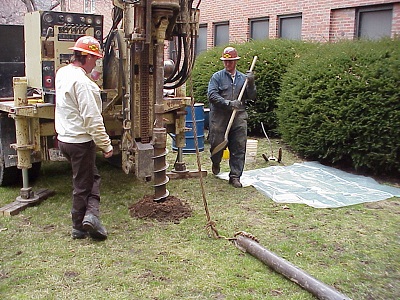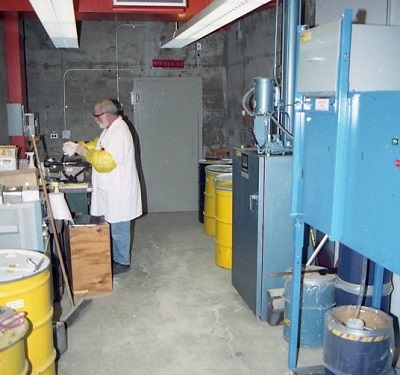Hi, Dr. Zoomie – I work at a place that used to use radioactive materials, but haven’t used them for a few decades. We still have a license for a few devices (lead paint analyzers) and I was trying to remove some of the locations where they used to do work, but my regulators told me I need to do some surveys and sampling to show that we didn’t contaminate the site. This is all new to me – can you help me get started?
Wow – this is something you can certainly do yourself, but unless you’ve got some experience developing and implementing survey and sampling plans, I’d recommend finding a consultant to help you, or to do the work for you. It’s going to cost you some money to go this route, but you’ll be a lot less stressed and there’s a far greater chance of getting it right the first (or second) time, which will save you time and money in the long run. If you do want to give it a shot on your own, I’d strongly recommend reviewing the MARSSIM manual and taking a class on it (you can find both here) – it’s not a simple process. If you decide to go the consultant route, I’d urge you to find someone who has experience in developing environmental survey and sampling plans, performing the work, and writing the resulting reports. I’ve gone through this several times – when working for a consulting firm, reviewing reports as a regulator, as an RSO who contracted this out to a consultant, and as a consultant working for a client; what I write here is based on that experience.
If you still want to do this yourself, here’s a high-level overview of what you’ll need to do – but to keep this under book-length I’m leaving out a lot of the details. The main things you’ll need to do are:
- Perform a thorough radiological survey of your site with special attention to areas more likely to have been contaminated
- Collect soil samples to send for analysis
- Perform radiological surveys (radiation and contamination) of any remaining structures in which radioactive materials were used
- Collect samples (if necessary) of areas that could possibly be contaminated
- Send samples for analysis
- Write report to summarize your work and what you found
- Submit report to regulators and cross your fingers
And here’s a little more detail on each of these steps!
1. Perform a thorough radiological survey of your site with special attention to areas more likely to have been contaminated
You’re likely going to want to do this on a grid; for a large site you might want to go with a 10m grid. Before you start surveying, perform a background count (at least 10 minutes, recording the total number of counts over that period of time) and then doing a count (at least 2 minutes, and preferably 5 or longer) at each grid location. What you’re trying to determine is the typical readings on the site and how much variability you find in your readings. If your readings are all fairly close to one another and to the background then it’s less likely that you’ve got contamination on your site; if there are some locations in which the readings are significantly higher than background then you might have some contamination that needs to be cleaned up. Oh – and in areas where radioactive materials were used, dumped, or stored you’ll want to have a tighter spacing of your survey points (maybe 1 m instead of 10).

2. Collect soil samples to send for analysis
You’ll need to collect samples – soil, most likely – from locations with elevated radiation levels and from some random locations as well. You’ll have to send the samples to a laboratory (hopefully accredited!) for analysis – get hold of their procedures for obtaining, storing, and shipping to the lab. The lab will likely send you the sample containers, tell you how they need to be preserved (luckily that’s pretty easy for radiological samples), and how to ship them. You will need to tell the lab what analyses you need to have run and what nuclides were in use back in the day. Something to keep in mind is that gross analyses (e.g. gross alpha/beta, gross counts, etc) can give a reasonably good go/no-go assessment and they’re relatively inexpensive. In other words, a gross alpha/beta analysis is one of the least expensive analyses that can be performed, but all it can tell you is whether or not you have elevated activity in that sample – it will not tell you what nuclide(s) is causing the spike. For that you’ll need to do spectroscopy – alpha, beta, or gamma – and that can start to get expensive.
If you’ve got elevated readings then you’ll have to be able to explain them to your regulators, and spectroscopy is the best way to do that. If your organization used to use alpha-emitters (e.g. thorium, radium, polonium) then you’ll need to do alpha spectroscopy; if they used gamma-emitters then gamma spectroscopy is the way to go; if they used beta-emitting nuclides then you should ask for liquid scintillation counting. If you’re not sure, tell the lab what nuclide(s) your employer used to use (this will be easier if you can find a copy of the old radioactive materials license) and they’ll know which analyses to run.


One other thing I almost forgot to mention – you’ll need to sample where you can reasonably expect radioactivity to have reached. If the organization had underground storage tanks then you’ll need to drill (or dig) down to sample the soil beneath the tanks (or where the tanks used to be); if they discharged into the sanitary sewer system then you’ll need to sample the sewer pipes and the soil beneath them; if they only had a loading dock or a parking lot where radioactive materials were handled then you can probably limit your sampling to the surface layers of soil or the concrete flooring of the loading dock.
3. Perform radiological surveys (radiation and contamination) of any remaining structures in which radioactive materials were used
If there are any structures remaining on the site you’re investigating then you’ll want to survey them, even if your records suggest they were never used for “hot” work.

Even if you have records showing that radioactive materials never entered the buildings, your regulators are likely to want more than your good word – ultimately it’ll likely be faster and cheaper to just do a survey, maybe send some samples for analysis, and show that the structures are clean.
4. Collect samples (if necessary) of areas that could possibly be contaminated
As before, if your surveys show any hot spots – or if your records show that there were spills of long-lived radionuclides then you’ll need to get some samples. These can be core samples of concrete flooring or walls, a sink trap and sections of piping, ventilation ducts, or whatever else it takes to support your investigation and (hopefully) your assertion that there’s no cleanup required.
5. Send samples for analysis
Hopefully you’ve already found a laboratory to analyze your samples for you; if not then you need to do that. And while it can be tempting to try to save some money (analytical work can be expensive), you want to have the best data possible to show your regulators – go with a lab that’s accredited and that has experience doing radiological analyses. If you’re not exactly sure which analyses to ask for, try talking with one of the radiochemists – if you can tell them what nuclides were on your former license they ought to be able to help you figure out a cost-effective way of analyzing for them. What the lab should do also is to send you sample containers, likely a cooler, and instructions for packing, preserving, and shipping the samples to them. You really need to follow their instructions to the letter – about the only place where there might be some slack is in the weight – you can send them more than what they ask for (e.g. 1.1 kg instead of 1 kg), but don’t send them less if at all possible and, if you have no choice, include a short explanation as to why. The lab should also send you a chain of custody form that you’ll need to fill out and include with the shipment as well as security seals for each of the sample containers and a log sheet in which you’ll note what’s in each container (e.g. “sediments from settling pond, sample location 3″). When the samples containers are all sealed, pack them in the cooler, ship them to the lab, and wait for the results. Oh – and one more thing – when your results come back, go through them carefully and make sure you understand them and what they mean. If you’ve got any questions, call the lab and ask – radiochemists don’t usually get many calls asking about their work
6. Write report to summarize your work and what you found
When you get your sample results back you’ll have a much better idea as to whether or not your site is contaminated – you’ll need to compare the results with the allowable concentrations for the radionuclide(s) that were found. And then…start writing! You’ll need to discuss the history of your company’s use of radioactivity, when that use stopped on your site, how you conducted all the activities we’ve been talking about here, include data tables from your surveys and samples, show a map of the locations you collected survey readings and samples, and anything else that seems relevant to your case. If you identified places that are contaminated to the point of requiring remediation then you’ll need to note that as well, indicating how you intend to do the cleanup (although no need for excessive detail here since you’ll be required to submit a remediation plan before you start excavating). When all is said and done, you’re likely looking at a document that’ll be anywhere from 50-100 pages in length…maybe more. Don’t pad it – but be complete.
7. Submit report to regulators and cross your fingers
Before submitting your report to your regulators it’s not a bad idea to ask someone to give it a read. If you know any full-time health physicists (especially if they’re board-certified!), it’s worth paying them a thousand dollars or so to give it a good read, point out weak points or missing sections, and find any mistakes or statements that might raise concerns. Make the changes they recommend, and then send it in to your regulators for their review. And then wait. You might hear back from them in a few weeks, but it might take a few or even several months. Maybe touch base with them to make sure it arrived (if you emailed it); aside from that, touch base with them quarterly until they finally get back to you with a response. I’ve had some reports that spent a year or more working their way through the bureaucracy – it just depends on how overworked and understaffed your regulators happen to be. And when they finally reply, you’ll need to address their concerns – whatever they happen to be – and resubmit and wait some more.
Chances are that your story won’t end here – but there are too many possibilities to explore them all. So I’ll end by saying good luck! And – again – unless you’ve done this before, I’d really recommend using a consultant if at all possible.